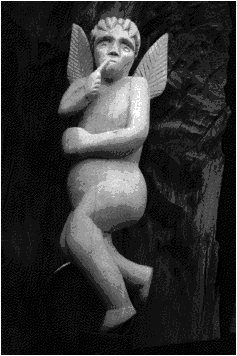Made Visible
The Vatican
Allen Duston,
Arnold Nesselrath
(Art Services International/Abrams)

We can recommend this angelic work to you, whether your favorites are the tiny, rubicund, roly-poly angels out of Reubens, or the more serious heavy-hearted ones from Blake (not represented here). An angel's job is, dare we say, no lark: he or she is required to deliver many sad messages to mankind. And perhaps we shouldn't remind you that, too, there are the Dark Angels, expertly described by Milton, one angel in particular who, to this day, much to the distress of some religions sits securely on the left hand of The Divine (they rarely mention who might first see up there when you pop off).
In the design of angels, you may prefer the no-nonsense Tzanès' "Saint Alypios" --- two angels treading barefoot on clouds, each carrying a long foolscap, messages, no doubt, from on high, addressed to Alypios, an august gentleman. As the text reports, "his face is austere, his beard venerable," and he is, at the moment, preoccupied not so much with the angels, but with speaking to us from atop a column, without toppling off... Exposed to the regard of men like the lamp on its lampstand.
Or perhaps you would prefer the bare variety, curly of hair, round and rosy of buttocks, tiny of wing, who appears to the drowsing Virgin of St. Helena, bearing a cross, "the True Cross of Jerusalem," in his tiny pink hands, he identified, by the commentator, as "a winged putto" --- which shows the vagaries of language, doesn't it? --- since the word has fairly steamy connotations in some other very Catholic corners of the world.
It's a book of angels, this one, with at least 250 angels, but who's counting? --- not the least a pale-faced, somewhat wrinkled and haggard one. He appears at the very beginning, with his own foolscap, reminding us that there are angels, and there are angels: those feathery-wing guys up there on the paintings, on the frescoes, on the ceilings and in the heavens --- but, too, in our times they've come up with another, being not so much a Cupid but more an angel of Cupidity --- the one that forks over the dough for strange and wonderful (and sometimes beautiful) volumes like this one.
This angel has no face --- at least not between the covers of The Invisible Made Visible. Also, he's no angel to you'd want to wrestle with. He's not necessarily the original Recording Angel, but close, close --- one, thus, possibly dear to the heart of the Vatican.
He's not referred to as Saint Robert, or The Venerable Angel Eaton --- but in more contemporary fashion, as Robert J. Eaton, Chairman of the Board, President and Chief Executive Officer, the Chrysler Corporation. This angel, presumably, has no wings, but he's given his own special page, page 13, putting him very high up in the hierarchy; a very solemn figure, intoning "Throughout the ages, mankind has called upon angels in every language and by many names..." and ending, O Angelus, from on high, the final holy incantation: "On behalf of the employees of Chrysler Corporation, and of our Chrysler, Plymouth, Dodge, Jeep, and Eagle (another feathery creature!) dealers, thank you for attending."
Thus Eaton is telling us that he and has fellow industrial angels live in heavenly Detroit, working not only for the betterment of mankind, but for an even better and divine ride --- here at the sign of the consuming angel. Hosanna!